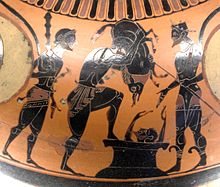
Back Еримантски глиган Bulgarian Hoc'h-gouez Erymanthos Breton Senglar d'Erimant Catalan Erymanthischer Eber German Ερυμάνθιος κάπρος Greek Jabalí de Erimanto Spanish Erymanthose metssiga Estonian Erimantoko basurdea Basque گراز اریمانتوس Persian Erymanthoksen metsäkarju Finnish
 Heracles, Eurystheus and the Erymanthian boar. Side A from an Ancient Greek black-figured amphora, painted by the Antimenes painter, ca. 525 BC, from Etruria. Louvre Museum, Paris. | |
| Grouping | Legendary creature |
|---|---|
| Folklore | Greek mythology |
| Country | Greece |
| Habitat | Mount Erymanthos |
In Greek mythology, the Erymanthian boar (Greek: ὁ Ἐρυμάνθιος κάπρος; Latin: aper Erymanthius) was a mythical creature that took the form of a "shaggy and wild"[1] "tameless"[2] "boar"[3] "of vast weight"[4] "and foaming jaws".[2] It was a Tegeaean,[4] Maenalusian[1] or Erymanthian[3] boar that lived in the "glens of Lampeia"[5] beside the "vast marsh of Erymanthus".[5] It would sally[6] from the "thick-wooded",[1] "cypress-bearing"[4] "heights of Erymanthus"[1] to "harry the groves of Arcady"[1] and "abuse the land of Psophis".[6]
- ^ a b c d e "Hercules Furens 228 ff.". Seneca's Tragedies. Vol. 1. Translated by Miller, Frank Justus. London; New York: William Heinemann; G. R Putnam's Sons. 1917. p. 21. ark:/13960/t71v5s15x.
- ^ a b "The Fall of Troy, Book VI. 220 ff.". Quintus Smyrnaeus The Fall Of Troy. Translated by Way, A. S. London; Cambridge, Massachusetts: William Heinemann Ltd; Harvard University Press. 1984 [1913]. p. 271. ark:/13960/t2m61f62d.
- ^ a b "Trachiniai. 1097". Sophocles The Plays and Fragments. Vol. 5 The Trachiniae. Translated by Jebb, R. C. Cambridge: The University Press. 1892. p. 159. ark:/13960/t6tx3f955.
- ^ a b c "The Heroides 9. 87 ff". Ovid Heroides And Amores. Translated by Showerman, Grant. London; New York: William Heinemann; The Macmillan Co. 1914. p. 115. ark:/13960/t76t0t11q.
- ^ a b "The Argonautica. Book 1 67-111". "The Argonautica" of Apollonius Rhodius. Translated by Coleridge, Edward P. London: George Bell And Sons, York Street, Covent Garden. 1889. p. 8. ark:/13960/t03x8577n.
- ^ a b "The Library 2. 5. 3-4". Apollodorus the Library. Vol. 1. Translated by Frazer, Sir James George. New York: G. P. Putnam's Sons. 1921. pp. 191 with the Scholiast. ark:/13960/t00012x9f.